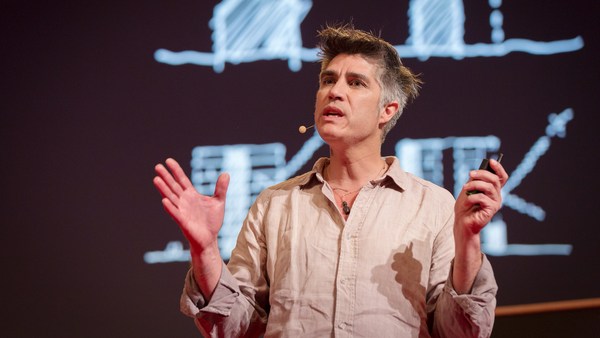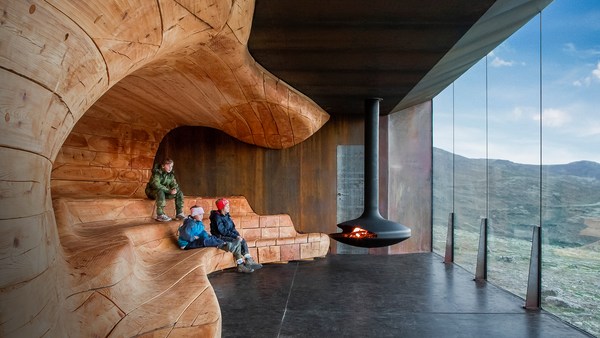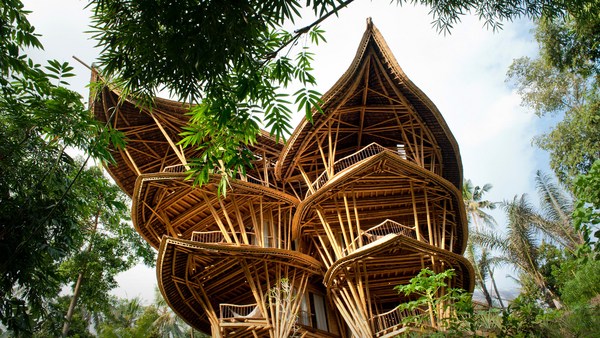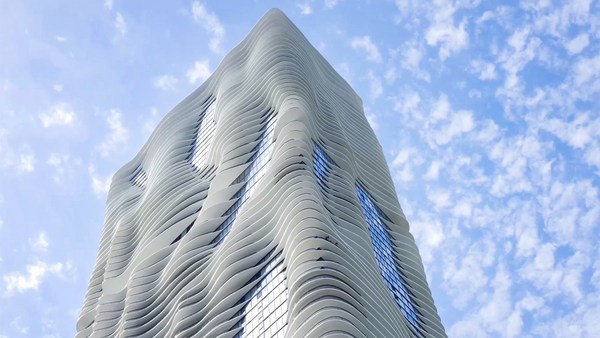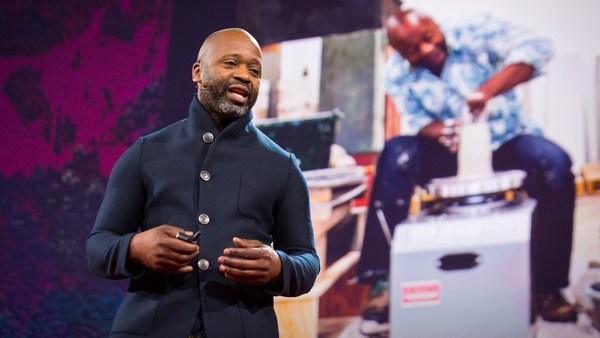For much of the past century, architecture was under the spell of a famous doctrine. "Form follows function" had become modernity's ambitious manifesto and detrimental straitjacket, as it liberated architecture from the decorative, but condemned it to utilitarian rigor and restrained purpose. Of course, architecture is about function, but I want to remember a rewriting of this phrase by Bernard Tschumi, and I want to propose a completely different quality. If form follows fiction, we could think of architecture and buildings as a space of stories -- stories of the people that live there, of the people that work in these buildings. And we could start to imagine the experiences our buildings create.
In this sense, I'm interested in fiction not as the implausible but as the real, as the reality of what architecture means for the people that live in it and with it. Our buildings are prototypes, ideas for how the space of living or how the space of working could be different, and what a space of culture or a space of media could look like today. Our buildings are real; they're being built. They're an explicit engagement in physical reality and conceptual possibility. I think of our architecture as organizational structures. At their core is indeed structural thinking, like a system: How can we arrange things in both a functional and experiential way? How can we create structures that generate a series of relationships and narratives? And how can fictive stories of the inhabitants and users of our buildings script the architecture, while the architecture scripts those stories at the same time?
And here comes the second term into play, what I call "narrative hybrids" -- structures of multiple simultaneous stories that unfold throughout the buildings we create. So we could think of architecture as complex systems of relationships, both in a programmatic and functional way and in an experiential and emotive or social way.
This is the headquarters for China's national broadcaster, which I designed together with Rem Koolhaas at OMA. When I first arrived in Beijing in 2002, the city planners showed us this image: a forest of several hundred skyscrapers to emerge in the central business district, except at that time, only a handful of them existed. So we had to design in a context that we knew almost nothing about, except one thing: it would all be about verticality.
Of course, the skyscraper is vertical -- it's a profoundly hierarchical structure, the top always the best, the bottom the worst, and the taller you are, the better, so it seems. And we wanted to ask ourselves, could a building be about a completely different quality? Could it undo this hierarchy, and could it be about a system that is more about collaboration, rather than isolation? So we took this needle and bent it back into itself, into a loop of interconnected activities. Our idea was to bring all aspects of television-making into one single structure: news, program production, broadcasting, research and training, administration -- all into a circuit of interconnected activities where people would meet in a process of exchange and collaboration.
I still very much like this image. It reminds one of biology classes, if you remember the human body with all its organs and circulatory systems, like at school. And suddenly you think of architecture no longer as built substance, but as an organism, as a life form. And as you start to dissect this organism, you can identify a series of primary technical clusters -- program production, broadcasting center and news. Those are tightly intertwined with social clusters: meeting rooms, canteens, chat areas -- informal spaces for people to meet and exchange. So the organizational structure of this building was a hybrid between the technical and the social, the human and the performative. And of course, we used the loop of the building as a circulatory system, to thread everything together and to allow both visitors and staff to experience all these different functions in a great unity.
With 473,000 square meters, it is one of the largest buildings ever built in the world. It has a population of over 10,000 people, and of course, this is a scale that exceeds the comprehension of many things and the scale of typical architecture. So we stopped work for a while and sat down and cut 10,000 little sticks and glued them onto a model, just simply to confront ourselves with what that quantity actually meant.
But of course, it's not a number, it is the people, it is a community that inhabits the building, and in order to both comprehend this, but also script this architecture, we identified five characters, hypothetical characters, and we followed them throughout their day in a life in this building, thought of where they would meet, what they would experience. So it was a way to script and design the building, but of course, also to communicate its experiences. This was part of an exhibition with the Museum of Modern Art in both New York and Beijing.
This is the main broadcast control room, a technical installation so large, it can broadcast over 200 channels simultaneously. And this is how the building stands in Beijing today. Its first broadcast live was the London Olympics 2012, after it had been completed from the outside for the Beijing Olympics. And you can see at the very tip of this 75-meter cantilever, those three little circles. And they're indeed part of a public loop that goes through the building. They're a piece of glass that you can stand on and watch the city pass by below you in slow motion.
The building has become part of everyday life in Beijing. It is there. It has also become a very popular backdrop for wedding photography.
(Laughter)
But its most important moment is maybe sill this one. "That's Beijing" is similar to "Time Out," a magazine that broadcasts what is happening in town during the week, and suddenly you see the building portrayed no longer as physical matter, but actually as an urban actor, as part of a series of personas that define the life of the city. So architecture suddenly assumes the quality of a player, of something that writes stories and performs stories. And I think that could be one of its primary meanings that we believe in.
But of course, there's another story to this building. It is the story of the people that made it -- 400 engineers and architects that I was guiding over almost a decade of collaborative work that we spent together in scripting this building, in imagining its reality and ultimately getting it built in China.
This is a residential development in Singapore, large scale. If we look at Singapore like most of Asia and more and more of the world, of course, it is dominated by the tower, a typology that indeed creates more isolation than connectedness, and I wanted to ask, how could we think about living, not only in terms of the privacy and individuality of ourselves and our apartment, but in an idea of a collective? How could we think about creating a communal environment in which sharing things was as great as having your own?
The typical answer to the question -- we had to design 1,040 apartments -- would have looked like this: 24-story height limit given by the planning authorities, 12 towers with nothing but residual in between -- a very tight system that, although the tower isolates you, it doesn't even give you privacy, because you're so close to the next one, that it is very questionable what the qualities of this would be.
So I proposed to topple the towers, throw the vertical into the horizontal and stack them up, and what looks a bit random from the side, if you look from the viewpoint of the helicopter, you can see its organizational structure is actually a hexagonal grid, in which these horizontal building blocks are stacked up to create huge outdoor courtyards -- central spaces for the community, programmed with a variety of amenities and functions. And you see that these courtyards are not hermetically sealed spaces. They're open, permeable; they're interconnected. We called the project "The Interlace," thinking that we interlace and interconnect the human beings and the spaces alike. And the detailed quality of everything we designed was about animating the space and giving the space to the inhabitants. And, in fact, it was a system where we would layer primarily communal spaces, stacked to more and more individual and private spaces. So we would open up a spectrum between the collective and the individual.
A little piece of math: if we count all the green that we left on the ground, minus the footprint of the buildings, and we would add back the green of all the terraces, we have 112 percent green space, so more nature than not having built a building. And of course this little piece of math shows you that we are multiplying the space available to those who live there. This is, in fact, the 13th floor of one of these terraces. So you see new datum planes, new grounds planes for social activity.
We paid a lot of attention to sustainability. In the tropics, the sun is the most important thing to pay attention to, and, in fact, it is seeking protection from the sun. We first proved that all apartments would have sufficient daylight through the year. We then went on to optimize the glazing of the facades to minimize the energy consumption of the building. But most importantly, we could prove that through the geometry of the building design, the building itself would provide sufficient shading to the courtyards so that those would be usable throughout the entire year. We further placed water bodies along the prevailing wind corridors, so that evaporative cooling would create microclimates that, again, would enhance the quality of those spaces available for the inhabitants. And it was the idea of creating this variety of choices, of freedom to think where you would want to be, where you would want to escape, maybe, within the own complexity of the complex in which you live.
But coming from Asia to Europe: a building for a German media company based in Berlin, transitioning from the traditional print media to the digital media. And its CEO asked a few very pertinent questions: Why would anyone today still want to go to the office, because you can actually work anywhere? And how could a digital identity of a company be embodied in a building? We created not only an object, but at the center of this object we created a giant space, and this space was about the experience of a collective, the experience of collaboration and of togetherness. Communication, interaction as the center of a space that in itself would float, like what we call the collaborative cloud, in the middle of the building, surrounded by an envelope of standard modular offices. So with only a few steps from your quiet work desk, you could participate in the giant collective experience of the central space.
Finally, we come to London, a project commissioned by the London Legacy Development Corporation of the Mayor of London. We were asked to undertake a study and investigate the potential of a site out in Stratford in the Olympic Park. In the 19th century, Prince Albert had created Albertopolis. And Boris Johnson thought of creating Olympicopolis.
The idea was to bring together some of Britain's greatest institutions, some international ones, and to create a new system of synergies. Prince Albert, as yet, created Albertopolis in the 19th century, thought of showcasing all achievements of mankind, bringing arts and science closer together. And he built Exhibition Road, a linear sequence of those institutions.
But of course, today's society has moved on from there. We no longer live in a world in which everything is as clearly delineated or separated from each other. We live in a world in which boundaries start to blur between the different domains, and in which collaboration and interaction becomes far more important than keeping separations. So we wanted to think of a giant culture machine, a building that would orchestrate and animate the various domains, but allow them to interact and collaborate. At the base of it is a very simple module, a ring module. It can function as a double-loaded corridor, has daylight, has ventilation. It can be glazed over and turned into a giant exhibitional performance space. These modules were stacked together with the idea that almost any function could, over time, occupy any of these modules. So institutions could shrink or contract, as, of course, the future of culture is, in a way, the most uncertain of all. This is how the building sits, adjacent to the Aquatics Centre, opposite the Olympic Stadium. And you can see how its cantilevering volumes project out and engage the public space and how its courtyards animate the public inside.
The idea was to create a complex system in which institutional entities could maintain their own identity, in which they would not be subsumed in a singular volume. Here's a scale comparison to the Centre Pompidou in Paris. It both shows the enormous scale and potential of the project, but also the difference: here, it is a multiplicity of a heterogeneous structure, in which different entities can interact without losing their own identity. And it was this thought: to create an organizational structure that would allow for multiple narratives to be scripted -- for those in the educational parts that create and think culture; for those that present the visual arts, the dance; and for the public to be admitted into all of this with a series of possible trajectories, to script their own reading of these narratives and their own experience.
And I want to end on a project that is very small, in a way, very different: a floating cinema in the ocean of Thailand. Friends of mine had founded a film festival, and I thought, if we think of the stories and narratives of movies, we should also think of the narratives of the people that watch them. So I designed a small modular floating platform, based on the techniques of local fishermen, how they built their lobster and fish farms. We collaborated with the local community and built, out of recycled materials of their own, this fantastical floating platform that gently moved in the ocean as we watched films from the British film archive, [1903] "Alice in Wonderland," for example. The most primordial experiences of the audience merged with the stories of the movies.
So I believe that architecture exceeds the domain of physical matter, of the built environment, but is really about how we want to live our lives, how we script our own stories and those of others.
Thank you.
(Applause)
